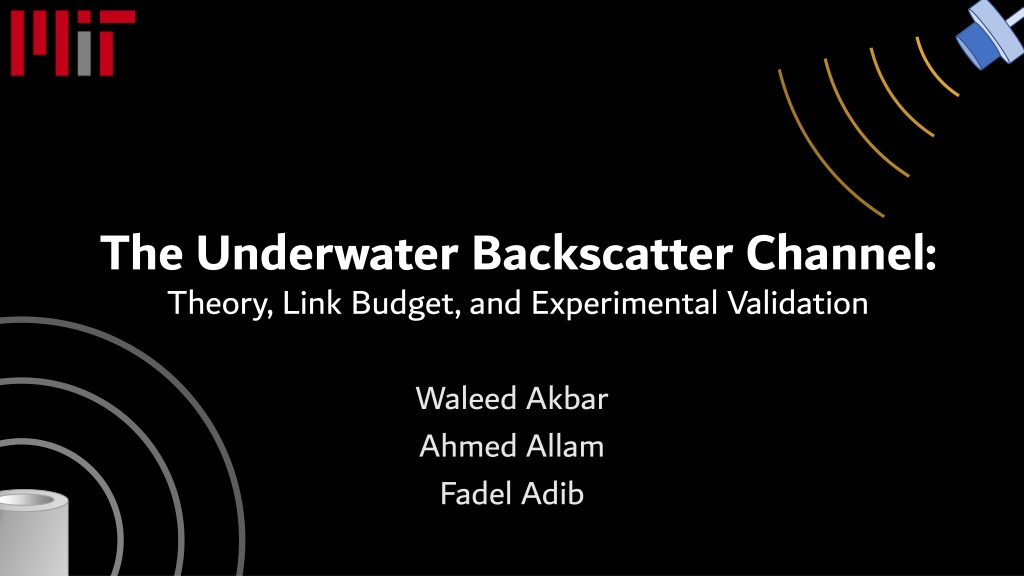Underwater Backscatter Channel: Theory, Link Budget, and Climate Monitoring
In response to the significant impacts of climate change on the world's oceans, a new technology called underwater backscatter is being developed for distributed ultra-low-power underwater sensor networks. This technology aims to enable climate monitoring, sea-level measurement, and hurricane response in coastal regions. The research includes theoretical modeling, experimental validation, and analysis of the communication range and capabilities of underwater backscatter systems.
- Underwater Technology
- Climate Monitoring
- Backscatter Communication
- Ocean Research
- Experimental Validation
Download Presentation

Please find below an Image/Link to download the presentation.
The content on the website is provided AS IS for your information and personal use only. It may not be sold, licensed, or shared on other websites without obtaining consent from the author. Download presentation by click this link. If you encounter any issues during the download, it is possible that the publisher has removed the file from their server.
E N D
Presentation Transcript
The Underwater Backscatter Channel: Theory, Link Budget, and Experimental Validation Waleed Akbar Ahmed Allam Fadel Adib
This Work is Motivated by Climate Change The ocean plays the largest role in the world s climate, and has been significantly impacted by climate change Significant need to monitor the ocean, especially in coastal regions Food security + climate-friendly food We have been developing underwater backscatter, a new technology for distributed ultra-low-power underwater sensor networks [SIGCOMM'19, SIGCOMM'20, OCEANS 20, Nature Communications 22, HotNets 22, HotMobile 22, SIGCOMM 23] Climate monitoring Sea-level + hurricane response
Backscatter Communication Traditional Acoustic Communication Acoustic waves Reflects an existing acoustic signal Consumes a ?? few of power Generates its own acoustic signal Consumes 10s of watts of power Backscatter Node
How far can we communicate using underwater backscatter?
End-to-End Link Budget Model Channel Transmitter ?2 ? ??? = 159.8 + 10log ?? + ???+ 10log + 2?????+ ???? 2?? ?? Signal-to-Noise Ratio Backscatter Node
End-to-End Link Budget Model First closed-form analytical model of underwater backscatter network ?2 ? Validated through empirical and numerical evaluation with a median error of ??? = 159.8 + 10log ?? + ???+ 10log <0.76dB across frequencies + 2?????+ ???? 2?? ?? Shows that the backscatter range can be extended to multiple kilometers even in its current form
Theory vs Practice ?2 ? ??? = 159.8 + 10log ?? + ???+ 10log + 2?????+ ???? 2?? ?? Tx Rx (hydrophone) Node 1 m Experimental Setup in the Charles River
Theory vs Practice Analytical (Theory) ??? ?2 ? = 159.8 + 10log ?? + ???+ 10log + 2?????+ ???? 2?? ?? Experimental Validation Tx Median deviation < 0.76 dB Rx Node (hydrophone) 1 m
Theory vs Practice Analytical (Theory) ??? ?2 ? = 159.8 + 10log ?? + ???+ 10log + 2?????+ ???? 2?? ?? Experimental Validation Tx Rx Node (hydrophone) 1 m
Let us focus on the key novel component of our end-to-end link budget
Backscatter Communication Traditional Acoustic Communication Rx Rx Tx ?? =????? ?? Differential Scattering Cross Section Incident Intensity (??) Reflected Power (?????) Channel Channel Tx
Differential Scattering Cross Section (??) ????? ?? ?? =
Differential Scattering Cross Section (??) ????? ?? ?? = Electrical ?? ????? ?? ?? ?? ? ?? ??? ?? Acoustic Directivity Piezoelectric Differential Reflection Coefficient Wavelength ??=?2?? 2 ???122 ????22+??2 ????? ?????2 ??1 |???+??1||???+??2| Electrical impedance mismatch = 2 4?
End-to-End SNR Tx 159.8 + 10log ?? + ??? Channel 2?? + ?? =?2?? 2 4? ??
End-to-End SNR ??? = ) + 10 ???( 159.8 + 10log ?? + ??? ?? Backscatter Node Gain ) ( 2?? + ?? Tx Gain Pathloss ?2 ? ??? = 159.8 + 10log ?? + ???+ 10log + 2?????+ ???? 2?? ?? Input Electrical Power Noise Impedance Mismatch
How far can we Communicate using Underwater Backscatter? = 0 dB
End-to-End Link Budget Model First closed-form analytical model of underwater backscatter Validated through empirical and numerical evaluation with a median error of <0.76dB across frequencies 01010101 Shows that the backscatter range can be extended to several kilometers ?? An interactive open-source tool to study backscatter systems: https://github.com/signalkinetics/linkbudget Datasets (1,500+ experimental trials) & Open-Source Code [SIGCOMM 23]: https://github.com/signalkinetics/vab







































